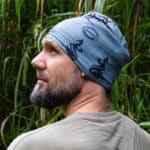December 2019 saw the largest release of sea turtles known in Guatemala. During the first week of December 16,643 baby olive ridley sea turtles were released on the Pacific Coast of Guatemala. The endangered turtles were released as part of ongoing long term conservation efforts by the local community project, Tortugario el Banco.
Olive ridley sea turtles are the smallest of the seven species of sea turtles.
Like all species of sea turtles, olive ridleys are considered threatened with extinction having suffered drastic population declines in recent years due to the over harvesting of eggs for human consumption. El Banco community member, and Director of Tortugario el Banco Juan Hildago says:
“It was these declines that led me to start the Tortugario at el Banco. Other members of the community saw what was happening and started helping by collecting eggs so we could incubate them and release the babies.”

Local community project Tortugario el Banco released the turtles.
Over the last 20 years Tortugario el Banco has worked with Guatemalan NGO Fundaselva to save sea turtles, and their efforts have seen baby turtle releases increase from 45,000 per year in 2014 to over 233,000 during 2018.
These increases show us just how important long-term efforts are for the conservation of sea turtles. With the commitment of the community of el Banco, these once scarce animals are coming back from the brink of extinction. It is so inspiring to see what can be achieved when a community comes together and works tirelessly to solve a conservation issue.
Biologists from Universidad del Valle de Guatemala and University of South Eastern Norway are currently using dataloggers to monitor the temperatures on the beach at el Banco and in the nests of eggs at Tortugario el Banco Daniel Ariano-Sanchez from the Department of Biology at Universidad del Valle says:
“In the face of climate change, and rising temperatures, it is critical for us to understand what is happening to the temperatures insea turtle nests. The sex of sea turtles is determined by the temperature at which the eggs are incubated. This means that if temperatures rise too high then only females will be produced. Or even worse, the embryos will die.”
- Thousands of olive ridley sea turtle hatchlings waiting to be released at Tortuario el Banco, Guatemala.
- Olive ridley sea turtles start their journey down the beach at el Banco on their way to the ocean.
- Over 5000 olive ridley sea turtles make their way to the surf of the Pacific Ocean.
- A student from Universidad del Valle de Guatemala measures a recently hatched turtle as part of an ongoing study investigating the effects of climate change on sea turtle embryo development.
- Record release makes the Guatemalan newspapers on 9th December 2019!
This blog was originally published here.







